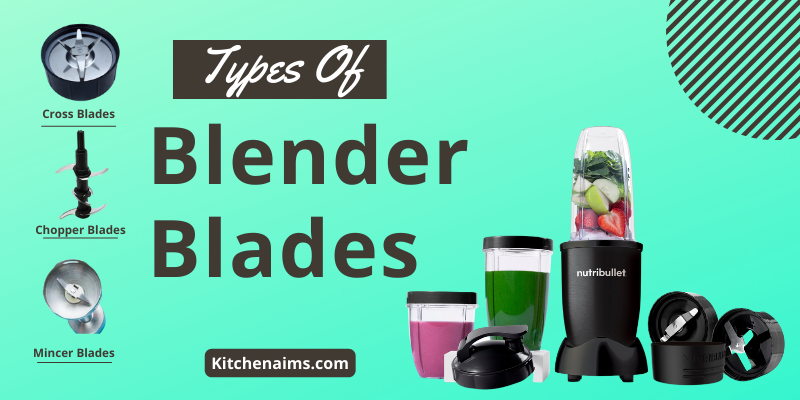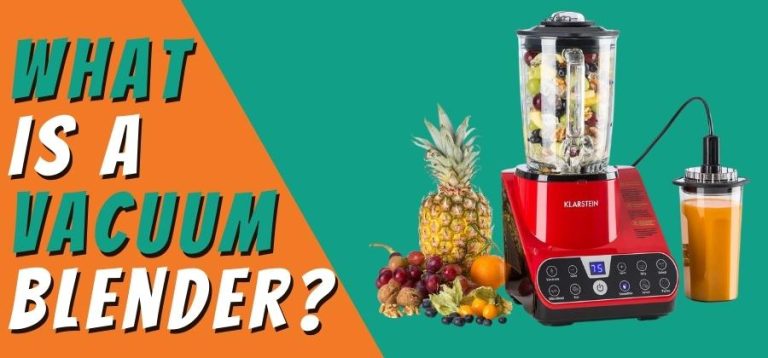Types Of Blender Blades & Their Uses According To Situation
For many consumers, blenders are a must-have kitchen tool. They come in many different forms and sizes, with various blade kinds to suit diverse needs. The blender blade can be used for various things, but it’s most commonly used to make soups and drinks. It’s built into certain appliances, such as smoothie makers, cocktail blenders, and milk-shake blenders.
Typically, blender blades are used for two purposes:
Some blades can blend or cut your components, while others can whip them into a perfect smoothie consistency. To make the best decision for your needs, you must first understand what you require. Let’s look at the different types of blender blades and how they’re used in this article.

Contents
Different Types Of Blender Blades And Their Uses
Blender blades come in a variety of shapes and sizes. Some are more frequent than others, although their capabilities and applications vary substantially.
Cross Blade

The “pencil sharpener” or cross-blade, which has two tapered sides at a 90-degree angle, is the most popular blade form. This blade has a unique design that lets it scrape the edges of the container so that all the ingredients are thoroughly mixed without any lumps remaining. Cross blades are best for preparing smoothies, milkshakes, baby purees, and anything else that requires a smoother texture.
However, it struggles to chop nuts and grate cheese because it has a limited surface area. Some models on the market have more giant blades to help with this.
Chopping Blade

The chopping or grinding blade, which has a single, broader edge, is the second type of blade. These blades give more touch to your ingredients, making them better at breaking nuts, grinding cheese, and pureeing veggies into a soup.
However, it cannot achieve the more acceptable consistency required for preparing smoothies or milkshakes. Therefore smoothies or milkshakes should be left to cross-bladed blenders.
Mincer Or Flaker Grater

A slicer or flaker grater, which resembles an enlarged pencil sharpener even without angled edges, is the third type of the blade for the blender.
The two simultaneous straight cutting blades slice objects like Parmesan cheese or veggies for a soup. Thinner blades on a mixer are less effective for making smoothies, and milkshakes because they cannot scrape all the components from the edges.
Whipping Blade

The whipping blade is designed in a star shape with several points to “whip” your ingredients.
These are great for sauces and purees since they blend instead of chopping or grating, which can cause undesirable heat build-up and burns your food. They can’t make a puree as acceptable as a cross blade, but they’re more adaptable.
How Do Blender’s Blades Work?
Blending is more than merely chopping food or ice into tiny pieces with a spinning blade. During the blending process, several different functions take place. The cutting procedure is the first thing that happens. Solid meals are broken down into smaller pieces by chopping, slicing, or smashing.
Flow is the second action that takes place. The sliced particles begin to move about the container due to the blades’ swirling effect. Circulation is the third action that takes place. The water content in the food is released as the food particles are sliced and begin to flow, generating a liquid.
The blade’s tremendous force pulls the liquid down to the jar’s bottom and then pushes it out the sides. The blending process is made possible by the interaction of cutting, flow, and circulation.
However, there is one last process in the mixing cycle called cavitation, where the magic happens. Tiny air bubbles emerge around the trailing edges of the blades as they spin during the mixing process.
When these bubbles implode, a tremendous shockwave is created within the blender jar, causing cavitation.
Why is this important?
Because the items being chopped eventually get too tiny for the blades to chop. They become too small a target for the edges as they flow and circulate. Cavitation creates a shockwave that breaks down the smaller pieces of food which were too tiny for the blades to cut.
How Do I Choose A Blender Blade?
It’s crucial to remember that not all blender blades are created equal. It can be challenging to make Nutella and peanut butter in a blender with a cross blade, but they will be better in a blender with chopping blades. Similarly, hummus dip won’t be made best with chopping blades rather, you will need whipping blades for great results.
Some variants come with two blades, one for whipping and the other for mincing. The choice between these blades is a matter of personal preference, as they all have their own set of applications.
You don’t know what type of blade your blender has. Unless otherwise mentioned in the product description, it is best to contact the manufacturer directly before making any online transactions.
FAQs?
Conclusion
Different types of blades are better suited to different kinds of food, depending on the consistency of the food. The number of blades in a blender ranges from two to five, with the usual blender having two or three different types of blades.
When choosing, think about how many blades you need and what kind of blade attachment each model offers, and which one is right for you. Make sure the model you choose is suitable for creating the specific foods you want, such as smoothies or soups.

Mery Webber
Mery Webber, the founder of Kitchen Aims, is a passionate home cook with extensive experience in the kitchen appliance industry. Through her blog, she aims to share her knowledge and help readers create the perfect kitchen.






